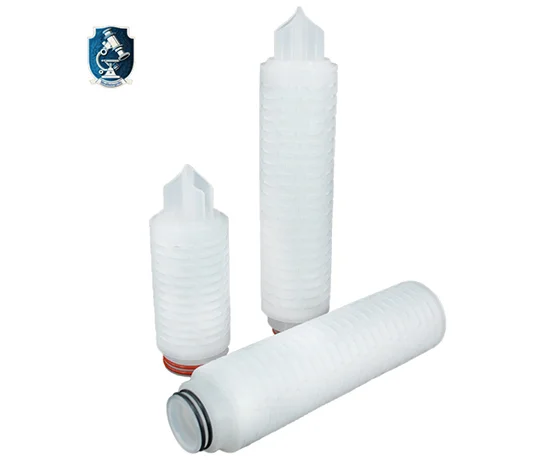How Cartridge Filter Pore Size Affects Water Cleanliness and Flow Speed
How Cartridge Filter Pore Size Affects Water Cleanliness and Flow Speed

Cartridge filters are vital components in numerous water purification systems. They offer a dependable way to eliminate unwanted substances from liquids and gases. Their performance hinges on several factors. Among these, pore size is highly significant. Understanding how pore size impacts filtration effectiveness, water cleanliness, and flow speed is essential. This knowledge aids in choosing the right filter for specific uses, such as home, industrial, or medical applications.
What Is a Cartridge Filter and How It Works
A cartridge filter is a tube-shaped device designed to capture particles and impurities. It traps these as fluid flows through it. Typically, these filters sit inside a housing. They function by pushing water or other fluids through a porous material. This material catches unwanted particles. The filter’s structure varies based on its material, like polypropylene (PP), PES, or PTFE. Yet, the core process remains the same. Fluid enters through the outer surface. It then passes through the filtering medium. Finally, it exits via the inner core, cleaner than before.
The Role of Pore Size in Filtration Effectiveness
Pore size refers to the width of tiny holes in the filter material. It decides which particle sizes can pass through. Smaller holes trap finer particles. However, they may slow the flow speed due to greater resistance. Larger holes, in contrast, allow faster flow. But they might let smaller impurities slip through. Thus, selecting the correct pore size is critical. It balances precise filtration with efficient operation.
The Relationship Between Pore Size and Water Cleanliness
Pore size directly affects water cleanliness. Smaller pores enhance the removal of impurities.
Micron Ratings and Their Impact on Impurity Removal
Micron rating indicates the smallest particle size a filter can reliably catch.
- Common Micron Sizes and Their Uses: Filters have various micron ratings, such as 0.1μm, 0.2μm, 1μm, 5μm, 10μm, 20μm, and up to 60μm. For instance, a 0.2μm filter is often used in medical settings for sterile filtration. It removes bacteria effectively. Industry standards, like ASTM F838, confirm its ability to produce clean water. This holds even when tested with high levels of the bacterium Brevundimonas diminuta.
- Removal Capabilities by Micron Rating:
- 1–0.2 μm: These capture bacteria and some viruses. They suit sterile applications.
- 1–5 μm: These remove fine dirt and larger microorganisms.
- 10–20 μm: These work for pre-filtration or clearing visible particles.
- 30–60 μm: These are used for rough filtration in industrial settings.
Influence on Microbial, Particulate, and Chemical Filtration
Smaller pore sizes excel at removing microbes. However, they may not suit all chemical needs unless paired with proper materials. For example, PES Filters combine fine filtration with strong chemical resistance. This makes them ideal for medical applications.

How Pore Size Affects Flow Speed
Choosing smaller pores improves cleanliness. Yet, it often reduces flow speed due to higher resistance.
Flow Resistance at Different Micron Levels
Smaller pores create more resistance to fluid flow. This happens because tiny pathways limit movement. As a result, throughput decreases. To counter this, higher pressure or a larger filter surface may be needed.
Pressure Drop Considerations Across Various Filter Grades
Finer filters cause a greater pressure drop. This occurs due to increased resistance across the filter’s length. System designs must account for this. Proper planning prevents pump overload or reduced efficiency.
Balancing Flow Speed with Filtration Accuracy
The challenge is to balance micron rating with system needs. Filters must remove impurities without slowing operations. Multi-stage filtration helps achieve this. Coarser filters start the process. Finer ones follow. This ensures both cleanliness and adequate flow speed.
Selecting the Right Cartridge Filter for Specific Applications
Choosing a suitable filter goes beyond pore size. It requires matching application needs, such as chemical compatibility and regulatory standards.
Matching Pore Size to Water Quality Needs
- Home Water Filtration: For household use, filters of 5–20 μm often suffice. They remove rust, sand, and visible impurities from tap water effectively.
- Industrial and Medical Uses: In medical settings, sterility is critical. Filters rated at ≤0.2 μm meet strict microbial removal standards.
Material Compatibility with Different Fluids and Chemicals
Material choice ensures filters withstand contact with process fluids:
- Polypropylene (PP): Great for general water filtration.
- 영어: PES는 영어를 구사하는 사람입니다.: Ideal for biological fluids due to low protein binding.
- PTFE: Its water-repelling nature suits gas or harsh solvents.
Overview of Common Cartridge Filter Materials and Designs
Knowing material properties helps refine filter choices based on needs.
Polypropylene (PP) Filters – HPP Series Highlights

PP filters in the HPP series provide strong particle capture across various micron ranges. They resist chemicals well. This makes them suitable for pre-filtration in water treatment systems.
PTFE Filters – Water-Repelling Membranes for Gas and Solvent Filtration
PTFE Filters resist harsh chemicals. Their water-repelling membranes excel in solvent-based or gas sterilization tasks.
Capsule Filters – Small Design for Low-Volume Uses

Capsule filters offer convenience and performance. Their compact, self-contained design fits lab-scale or single-use systems. They save space without sacrificing filtration quality.
Factors Influencing Filter Performance Beyond Pore Size
Pore size is crucial. However, other factors also affect performance significantly.
- Temperature, Pressure, and Chemical Exposure: High temperatures or incompatible chemicals can damage filter materials over time. Choosing materials rated for specific conditions is essential.
- Maintenance and Replacement Timing: Regular replacement maintains performance. Clogged filters reduce flow speed and impurity removal, even if their micron rating stays the same.
MedIntegrity: Your Partner for High-Cleanliness Filtration Solutions
Selecting the right filter matters as much as trusting its maker. 메드인티그리티, a U.S.-based company, specializes in precision tools and high-quality consumables for the medical industry.
Expertise in High-Cleanliness Medical Consumables
MedIntegrity’s expertise extends beyond testing tools. It includes crafting critical filtration products. Our cartridge filters meet the strict demands of medical clients. They ensure reliability from raw material processing to final products.
Commitment to Innovation, Quality, and Standards
We prioritize quality and regulatory compliance. Our filters meet FDA and GMP standards, as well as USP and EP requirements. This ensures safety in critical environments like cleanrooms and sterile production zones.
Product Range Supporting Critical Cleanroom Operations
Our offerings include a wide range of Cartridge Filters and Filter Housings. These support thorough contamination control strategies. We provide a dependable, single source for filtration needs.
Summary of Insights on Pore Size, Cleanliness, and Flow Speed
Choosing the right cartridge filter involves evaluating several factors:
- Importance of the Right Micron Rating: A micron rating that’s too large risks poor purification. Conversely, overly small pores may reduce efficiency due to pressure drops or slower flow.
- Trade-Offs Between Flow and Impurity Removal: An ideal solution balances these factors. Multi-stage filtration systems, tailored to specific needs, achieve this. They range from rough dirt removal to final sterile filtration.
- Long-Term Benefits of Proper Filter Choice: Well-matched filters lower maintenance costs. They also ensure compliance with medical standards, vital for pharmaceutical production.
자주 묻는 질문
Q1: What does “micron rating” mean in cartridge filters?
A: A micron rating shows the smallest particle size a filter can reliably remove. For example, a 5-micron filter captures particles 5 microns or larger while letting smaller ones pass.
Q2: How often should cartridge filters be replaced?
A: Replacement depends on water quality and volume processed. It may range from weeks in heavy-use systems to months in cleaner settings. Regular checks ensure steady performance.
Q3: Can I use a finer pore size for better filtration in all cases?
A: Finer pores enhance impurity removal. However, they increase resistance and slow flow speed. This may not suit systems needing high throughput. Always match pore size to your specific needs for optimal results.







